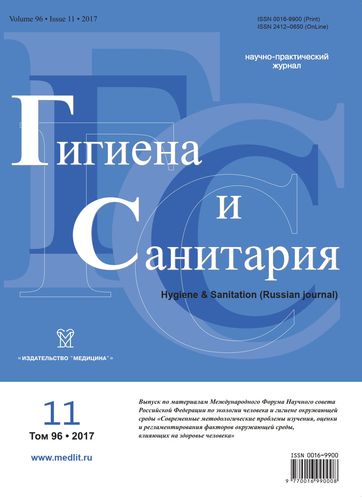Physico-chemical investigations for the assessment of the chemical safety and efficacy of application of a new system of landfill gas purification at the solid domestic garbage dump
- Authors: Malysheva A.G.1, Kozlova N.Y.1, Rastyannikov E.G.1, Ermakov A.A.1, Shokhin V.A.1
-
Affiliations:
- Center for Strategic Planning and Management of Biomedical Health Risks
- Issue: Vol 96, No 11 (2017)
- Pages: 1103-1108
- Section: METHODS OF INVESTIGATIONS
- Published: 21.10.2020
- URL: https://ruspoj.com/0016-9900/article/view/640750
- DOI: https://doi.org/10.47470/0016-9900-2017-96-11-1103-1108
- ID: 640750
Cite item
Full Text
Abstract
Landfills of municipal solid waste (MSW) have a negative impact on the environment and people: air, soil, surface water and groundwater are polluted. During the storage of MSW in the body of the landfill natural anaerobic decomposition of organic waste takes place under conditions of oxygen lack, high temperature and humidity. One product of this process is landfill gas — a mixture of methane and carbon dioxide with small amounts of impurities (nitrogen, silicon, sulfur, hydrogen sulfide). Tens and hundreds of different organic compounds are also included as a compound of landfill gas. The composition and content of the individual components in landfill gas depends on the composition of landfilled waste at the solid domestic garbage dump. The landfill gas and odor run to great distances. Construction, operation and closure of landfills give rise to a number of environmental problems associated with such a classification of landfills as a secondary source of pollution of the urban environment. The solution of such environmental problems offers a variety of options for the “recovery”, “remediation” and protective measures in areas of placement of landfills. For example, in the landfill “Timokhovo” there were studied the efficacy and safety of a new chemical treatment technologies and disposal of landfill gas As a result of the installation of the system for landfill gas purification there was established the decline in the total concentration of polluting compounds, as hydrocarbons (including saturated and aromatic), alcohols, oxygen and sulfur containing compounds by from 63 to 2200 times. There was reached 100% disposal of mercaptanes, sulfides, di- and trisulfides, naphthenic and terpenic hydrocarbons and chlorinated compounds. The number of identified compounds was reduced by more than 2 times. However, at the output of the purification system there were revealed compounds not identified at the input of this system. It can be regarded due to the appearance of transformation products of flaring hydrocarbons. Gas chromatography-mass spectrometry studies directed to the identification with quantitative assessment of air emissions before and after the new system of utilization allow both perform monitoring emissions taking into account the real content and changes in group and component structure under the influence of the chemical impact of the new technologies and make recommendations for further improvement of gas purification systems in terms of environmental aspects.
About the authors
Alla G. Malysheva
Center for Strategic Planning and Management of Biomedical Health Risks
Author for correspondence.
Email: fizhim@yandex.ru
MD, PhD, DSci., Prof., head of the laboratory of physical and chemical research of the Center for Strategic Planning and Management of Biomedical Health Risks , Moscow, 119991, Russian Federation.
e-mail: fizhim@yandex.ru
Russian FederationN. Yu. Kozlova
Center for Strategic Planning and Management of Biomedical Health Risks
Email: noemail@neicon.ru
Russian Federation
E. G. Rastyannikov
Center for Strategic Planning and Management of Biomedical Health Risks
Email: noemail@neicon.ru
Russian Federation
A. A. Ermakov
Center for Strategic Planning and Management of Biomedical Health Risks
Email: noemail@neicon.ru
Russian Federation
V. A. Shokhin
Center for Strategic Planning and Management of Biomedical Health Risks
Email: noemail@neicon.ru
Russian Federation
References
- Petrov V.V., Guseva A.Yu., Gusakova N.V., Vorob’ev D.M. The ensuring of the functioning of urban environmental data monitoring system for the management of production and consumption waste in Taganrog. Inzhenernyy vestnik Dona. 2012; (4-2). Available at: http://ivdon.ru/magazine/archive/n4p2y2012/1350/ (in Russian)
- Hong J., Li X., Zhaojie C. Life cycle assessment of four municipal solid waste management scenarios in China. Waste Manag. 2010; 30(11): 2362–9.
- Bovea M.D., Ibáñez-Forés V., Gallardo A., Colomer-Mendoza F.J. Environmental assessment of alternative municipal solid waste management strategies. A Spanish case study. Waste Manag. 2010; 30(11): 2383–95.
- Sheina S.G., Babenko L.L., Nedel’ko S.S., Kobaliya N.B. The control system of solid household waste using GIS-technologies. Inzhenernyy vestnik Dona. 2012; (4-2). Available at: http://ivdon.ru/ru/magazine/archive /n4p2y2012/1258/ (in Russian)
- Center for Strategic Studies of the Fuel and Energy Complex of the Far East. Analytic note. «The energy potential of landfill gas at landfills». Available at: http://fecsrfec.ru/upload/iblock/488/488126c7a984fc266ebb2400c8257acb.pdf (in Russian)
- Gurvich V.I., Lifshits A.B. Production and utilization of landfill gas – the independent sector of World industry. Ekologicheskie sistemy. 2005; (5). (in Russian)
- Dedikov D.S. Report «Prospects for the use of alternative energy sources (the example of the landfill gas and nuclear energy)». Available at: http://www.osatom.ru/mediafiles/u/files/VIII_forum_2013/Dedikova_D.S.pdf (in Russian)
- Malysheva A.G., Rastyannikov E.G., Bezzubov A.A., Kozlova N.Yu., Baeva I.V., Abramov E.G. Analytical studies of assessing the safety and efficacy of new technologies in Environmental Medicine. Gigiena i sanitariya. 2006; 85(1): 32–4. (in Russian)
- Malysheva A.G., Rakhmanin Yu.A., Rastyannikov E.G., Kozlova N.Yu., Artyushina I.Yu., Shokhin V.A. Gas chromatography-mass spectrometry’s study of volatile plant discharge to evaluate the efficacy and safety of the environmental phytotechnologies’ improvement. Gigiena i sanitariya. 2016; 95(6): 501–7. (in Russian)
- Malysheva A.G. Regularities of the transformation of organic compounds in the environment. Gigiena i sanitariya. 1997; 76(3): 5–10. (in Russian)
- Malysheva A.G., Rakhmanin Yu.A. The Physical and Chemical Studies and Methods of Substances Control in the Environmental Hygiene [Fiziko-khimicheskie issledovaniya i metody kon-trolya veshchestv v gigiene okruzhayushchey sredy]. St. Petersburg: Professional; 2012. (in Russian)
Supplementary files









